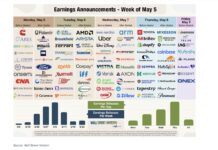 Everyone’s got a story behind how their interest, activity and even fascination with “the market” began. Some grow up in a multi-generational wealth management business; others work through the B-school route, obtain an enviable academic pedigree and go to work for a wire house or brokerage firm. And then there are the people like me: those who began investing or trading almost by accident, but through a long and winding path of improbable events developed an involvement with markets that extends well beyond a hobby.
Everyone’s got a story behind how their interest, activity and even fascination with “the market” began. Some grow up in a multi-generational wealth management business; others work through the B-school route, obtain an enviable academic pedigree and go to work for a wire house or brokerage firm. And then there are the people like me: those who began investing or trading almost by accident, but through a long and winding path of improbable events developed an involvement with markets that extends well beyond a hobby.
Whatever your background, your insights on markets and process are as unique as the place you came from and road you’ve traveled. These are a few of the guiding assumptions and aphorisms I’ve developed as my cross-disciplinary academic background in philosophy, history, social and hard sciences has passed through the filter of over 10 years as an active trader and technician. Keep in mind, this is far more dense than your run-o’-the-mill “8 Unbeliebable DAX Stocks Justin Bieber’s German Customs-Confiscated Pet Chimpanzee is Trading RIGHT NOW!” list.
So, spoiler: no chimps [audience shuffles hastily towards rear exit doors]; but hopefully a new insight or two.
Markets are Functionally Irreducible.
The market is a social medium and an organized microcosm of the social world. It is a pliable and reflexive construct of human participants (directly or by programmed proxy) and human observers ceaselessly acting and being acted upon by one another. Proximate and plausible causes for any event in the market exist and can be inferred easily; but the real body of causal variables determining a market’s price in any given moment is irretrievably complex. The identity of these variables exist, but we lack both the computational apparatus and analytical acuity adequate to apprehend them. As a result, markets are “functionally irreducible”.
Markets Are Made of Narrative Creatures.
Humans are homo narratus – born storytellers. Narrative is something inherent to our anthropological makeup; some even posit it is what makes the stream of our consciousness intelligible and is vital to the structure of memory and identity formation. Our minds/brains “speak narrative”. This faculty for creating narrative and the employment of a sophisticated set of heuristic tools used to accommodate new stimuli (events, information, people) is an autonomic process, similar to breathing or our awareness of bodily orientation in space. Narrative carries mnemonic (memory-aiding), persuasive and transfer-of-knowledge benefits; and also (more importantly for our market-related behavior) provides for avoidance of the pain, adverse circumstances and inability to extrapolate future probabilities that often accompany random or inexplicable events.
Market observers irresistibly apply this capability to raw market developments, looking for proximate causes and attributing them where apparent; or authoring and imposing them where the cause and narrative antecedents are hidden or prove too difficult to discern. As with the wider world, we frame the world of “the market” in stories, beginning with our self-referential conception of “I” and moving outward.
Financial news media is founded on and relies on this human compulsion for narrative for its success. Because markets are functionally irreducible, the reason events occur or their implications are not always or even usually evident. Media such as financial news channels, newsletters, prominent news websites and the sell-side analytical community are generally adept at analyzing emerging market events and synthesizing them into a coherent narrative. The ‘stories’ that result vary widely in quality and break fidelity with the probable cause of an event as often not while reporting; to say nothing of the storyteller’s inherent bias or agenda. However fallible or dubious their analysis, these outlets often enjoy large audiences and significant profits because of the breadth of and talent behind their narrative expertise.
The need to place a stock, sector, industry, policy or personality in a plausible narrative context is constant and pervasive; and consequently a profitable market for information abides where the power is in the telling, not derived from the value of what is told.
In Markets, Here Is No Why*. (h/t Billy Corgan)
Markets are and will always be inefficient because they are driven by narrative-derived expectations. Certitude behind the reason why a market or instrument’s price prints where it does at any time isn’t possible, so what is more or less probable is deemed sufficient. Reliable probabilistic assignment of causes has difficult methodological problems and is usually much too impractical to provide a sound procedural basis for active market decisions. Crude narrative formation or adoption from mass outlets is typically substituted; and disappointed expectations often the result. One path of remedy is creation of tractable yet rigorous models scoring pertinent fundamental, technical, sentimental, quantitative and news-based variables; while another is renunciation of narrative-based analyses and explanations: in effect, a renunciation of the analytical pursuit of why.
Markets are Beset by The Scandal of Irrationality.
Market observers are not indiscriminate creators and consumers of narrative; generally, their base criterion is that the narrative must be probable; and therefore rational. Critically, adoption of a rational market story is perceived as necessary for extrapolation of future outcomes that are rationally expected. What emerges is a meta-narrative in which a story (“this narrative is well-founded with a basis in rigorous, evidence-based analysis”, “this narrative was formulated by a reputable analyst whose opinions I respect and pay to receive” etc.) is told about the market story adopted. Elaborate narrative structures imply an investment of resources such as time, imagination and possibly money that make their failure more difficult to contemplate and can result in inflexible or implastic market perspectives – even more so where capital has been allocated on the basis of the structure’s sophistication or origin.
The result of our adoption of narrative structures is that they can structurally occlude the poor assumptions, sloppy analytical processes, major contradictions and cognitive biases at work from consideration. When markets inevitably deviate from the path we suppose they “ought” to follow or abruptly and “inexplicably” react in unanticipated ways, this aberrant behavior is then pegged as irrational and a violation of the rationally-based narrative order. The more implastic or overly-committed, the more scandalous the anomaly. “Oughtness” – the idea there is some rational time-and-price path along which a market should travel – suggests a descriptive market ethic – a reason why.
Much as it might comfort us and provide for the cohesion of fashionable market theories: there is no reliable, meaningful definition of a “rational market” – none that makes accommodates and adequately treats the radical bouts of inefficiency and irrationality markets all-too-often manifest. No surprise then that any narrative-based extrapolation of why – and the market advice that usually accompanies it – falls flat on its face.
The painful lessons of boom and bust, bubble and crash, irrational exuberance and equally irrational panic – driven by the deceptive snare of rationality – are taught again and again; but the stubborn shock and “scandal of irrationality” persist.
Thanks for reading! Stay tuned for Part 2….
Twitter: @andrewunknown and @seeitmarket
Author holds no position in any securities mentioned at the time of publication.
Any opinions expressed herein are solely those of the author, and do not in any way represent the views or opinions of any other person or entity.
*”Here Is No Why” featured on The Smashing Pumpkins’ Mellon Collie and the Infinite Sadness © 1995 chrysalis songs/cinderful music (bmi)








